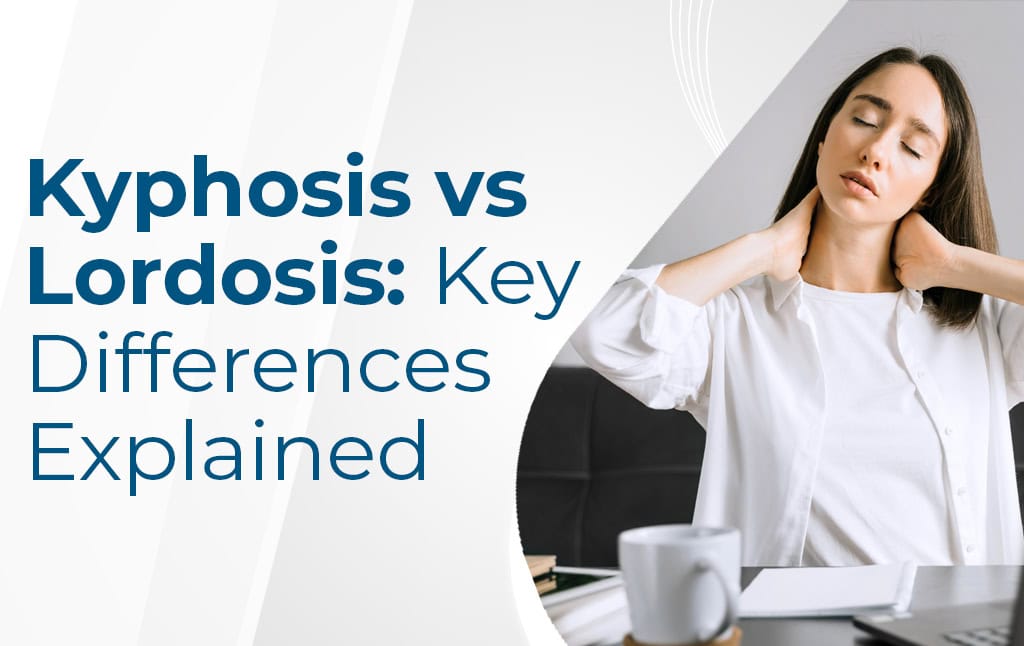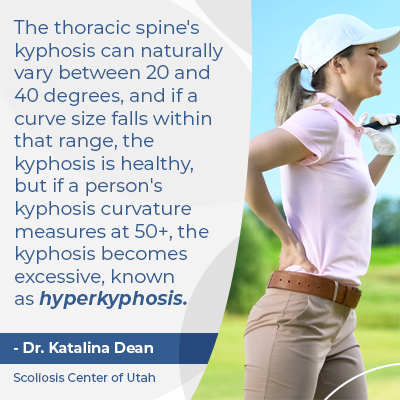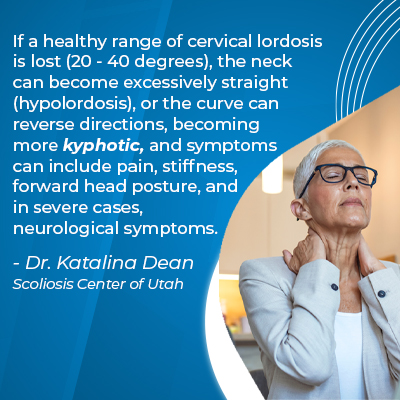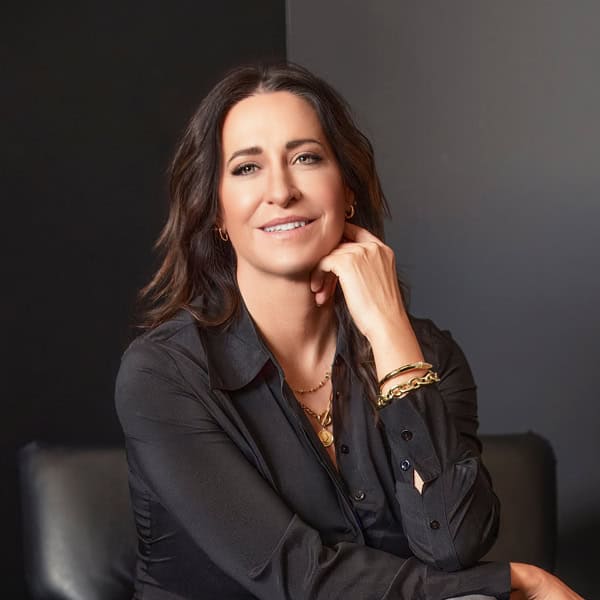Blogs
Kyphosis vs Lordosis: Key Differences Explained

The spine’s balance and alignment can affect the entire body and is shaped by the spine’s curvatures. While healthy spinal curves can vary in size, if a person’s kyphosis or lordosis doesn’t fall within a normal range, a curve can become unhealthy and problematic.
The spine’s healthy curves are key to its balance, strength, and function. Kyphosis refers to an outward curvature of the spine, while lordosis refers to an inward spinal curvature. Kyphosis can be found in the middle/upper back, while lordotic curves characterize the neck and lower back.
There are a number of conditions that involve a loss of healthy spinal curves, two of which are kyphosis and lordosis.
The Spine’s Healthy Curves
It’s important to understand the difference between healthy and unhealthy spinal curvatures because overall spinal health can be affected by the development of unhealthy spinal curvatures.
If the spine’s healthy curves are in place, its position is aligned and straight. The spine is curved at each of its main sections: the neck (cervical spine), the middle/upper back (thoracic spine), and the lower back (lumbar spine).
The health and alignment of each section is affected by the other sections, so the loss of a single spinal curve can disrupt the biomechanics of the entire spine.
Two types of spinal curvatures are kyphosis and lordosis, and these curves can be healthy or unhealthy, depending on their size.
Kyphosis
Kyphosis is an outward-bending spinal curvature that’s found in the thoracic spinal section.
The thoracic spine is the largest spinal section and the only section that attaches to the rib cage. The thoracic spine helps protect the lungs and heart, the spinal cord, anchors the rib cage, and enables upper body movement.
 The thoracic spine’s kyphosis can naturally vary between 20 and 40 degrees, and if a curve size falls within that range, the kyphosis is healthy, but if a person’s kyphosis curvature measures at 50+, the kyphosis becomes excessive, known as hyperkyphosis.
The thoracic spine’s kyphosis can naturally vary between 20 and 40 degrees, and if a curve size falls within that range, the kyphosis is healthy, but if a person’s kyphosis curvature measures at 50+, the kyphosis becomes excessive, known as hyperkyphosis.
The main symptom of hyperkyphosis is an excessively rounded-forward upper back and shoulders, and back pain, nerve pain, and mobility issues are also common.
There are also different types of kyphosis: postural kyphosis, Scheuermann’s kyphosis, and congenital kyphosis.
Postural Kyphosis
Postural kyphosis is the most common type; it’s caused by chronic poor posture and most often occurs during adolescence.
Over time, chronic poor posture like slouching or sitting for long periods of time without back support can weaken postural muscles and cause the upper back to develop an unhealthy level of kyphosis.
Because the kyphosis isn’t structural, the curve is flexible and can be altered with a change in body position.
Postural kyphosis treatment commonly includes physical therapy and lifestyle guidance.
Scheuermann’s Kyphosis
Scheuermann’s Kyphosis is also most often diagnosed during adolescence, but unlike postural kyphosis, Scheuermann’s kyphosis is structural.
With structural abnormalities and curves, a change in position can’t alter the curve as it’s rigid and caused by the wedging forward of certain vertebrae because they are more triangular in shape than healthy rectangular-shaped vertebral bodies.
Symptoms of Scheuermann’s kyphosis also include rounded-forward posture, back pain, nerve pain, and the inability to straighten the spine.
Scheuermann’s kyphosis is more complex to correct, and treatment can involve physical therapy, corrective bracing, and in severe cases, surgical intervention.
Congenital Kyphosis
Congenital kyphosis is caused by the spine not forming properly in utero, so babies are born with the abnormal curvature of the spine.
Vertebral bodies can be misshapen, incomplete, or can fail to form into separate bones, instead becoming fused together and causing the thoracic spine to wedge forward and develop excessive kyphosis.
Symptoms of congenital kyphosis include an excessively rounded forward upper back, uneven shoulders, forward head posture, and in severe cases, neurological symptoms can also occur.
Treatment options include bracing, physical therapy, and surgery.
So as you can see, there are different types of kyphosis, and as the spine’s lordosis is found in the cervical and lumbar spinal sections, the neck and lower back are most affected.
Lordosis
The spine curves inward at the cervical and lumbar spinal sections:lordotic curves.
The neck’s healthy curve facilitates its ability to support the weight of the head and the neck’s range of motion.
The cervical spine is also the bridge between the brain, the spine, and the rest of the embody, so a loss of the neck’s healthy curves can also disrupt brain-body communication.
 If a healthy range of cervical lordosis is lost (20 – 40 degrees), the neck can become excessively straight (hypolordosis), or the curve can reverse directions, becoming more kyphotic, and symptoms can include pain, stiffness, forward head posture, and in severe cases, neurological symptoms.
If a healthy range of cervical lordosis is lost (20 – 40 degrees), the neck can become excessively straight (hypolordosis), or the curve can reverse directions, becoming more kyphotic, and symptoms can include pain, stiffness, forward head posture, and in severe cases, neurological symptoms.
A loss of cervical lordosis can be caused by injury, poor posture, a muscular imbalance, or the presence of an underlying spinal condition like osteoporosis or scoliosis.
Treatment options can include physical therapy, chiropractic care, lifestyle guidance, and in severe cases, surgery.
While the cervical spine can be affected by a loss of lordosis, lumbar lordosis is more common.
Lumbar Hyperlordosis
A diagnosis of lumbar hyperlordosis means the lower back curves excessively inward, causing a swayback appearance where the buttocks and abdomen protrude excessively.
A healthy range of lumbar lordosis would fall between 40 and 60 degrees.
Lumbar hyperlordosis symptoms include postural changes, the inability to lay flat with the lower spine touching the floor (there will always be a gap), back pain, muscle pain, and mobility issues.
Lumbar hyperlordosis can be caused by chronic poor posture, a muscular imbalance, excessive kyphosis in the upper back (hyperlordosis forms as a compensatory curve), lifestyle factors, and the presence of an underlying condition like scoliosis.
Common treatment options include physical therapy, postural correction, bracing, pain management, and lifestyle guidance.
Kyphosis, Lordosis, and Scoliosis: What’s The Connection?
As mentioned, there are a number of conditions that can cause the spine to lose its healthy curves, and while kyphosis, lordosis, and scoliosis are distinct conditions, they can occur together, and scoliosis can contribute to the loss of healthy lordosis in the cervical and lumbar spinal sections.
Kyphosis and lordosis can occur together in cases where the excessive outward curvature of the thoracic spine causes the lumbar spine to develop a compensatory curve below to counteract the uneven forces of the unnatural spinal curve above.
Compensatory curves can also develop in scoliosis where the spine’s unnatural bend and twist in one section can cause the loss of a healthy curve in another spinal section.
While scoliosis isn’t known to cause excessive kyphosis, the two conditions occur together as kyphoscoliosis, and scoliosis is associated with a loss of the cervical spine’s healthy lordosis and lumbar hyperlordosis.
As scoliosis causes the spine to bend unnaturally to the side and rotate, if it develops in the cervical spine, this can cause a loss of the neck’s healthy lordosis and a straightening of the curve.
Scoliosis is also known to cause muscular imbalance, so if cervical scoliosis has caused the muscles that support the cervical spine to become unbalanced, this can further disrupt the neck’s ability to maintain its healthy curve and alignment.
Lumbar scoliosis causes the lower spine to bend and twist unnaturally so can cause the lower back to curve inward excessively, and a scoliosis-related muscular imbalance can also contribute to the development of lumbar hyperlordosis.
Conclusion
The spine’s healthy curves are important; they help maintain its strength, flexibility, balance and alignment.
There are a number of spinal conditions that cause unhealthy spinal curvatures to develop.
Kyphosis refers to the thoracic spine’s outward curvature, and if it becomes excessive, the upper back and shoulders become excessively rounded forward: hyperkyphosis.
Lordosis is the opposite curve type that bends inward at the cervical and lumbar spinal sections. A loss of the neck’s healthy lordosis can involve the curve straightening out or reverses; this interferes with the cervical spine’s ability to support the weight of the head and facilitate the neck’s wide range of motion.
Hyperlordosis is more common in the lumbar spine and causes a swayback appearance as the excessive inward curvature of the lower back causes the abdomen and buttocks to protrude.
Scoliosis causes the spine to develop an unnatural lateral-bending spinal curve that also rotates, and when scoliosis and hyperkyphosis occur together, it’s known as kyphoscoliosis.
Scoliosis that affects the cervical and/or lumbar spinal sections can contribute to the loss of healthy lordotic curves.
Here at the Scoliosis Center of Utah, the potential effects of scoliosis are minimized through proactive treatment that works towards restoring the spine’s alignment and balance for 3-dimensional postural correction.

Dr. Katalina Dean
Dr. Katalina Dean is the founder and clinical director of Scoliosis Center of Utah, in Midvale, UT. Her team specializes in posture correction, spinal rehabilitation, and non-invasive scoliosis care and bracing.
Call Today
Do You Qualify for Care?
Schedule an Appointment Below
